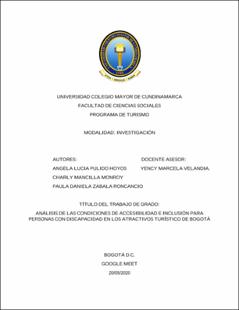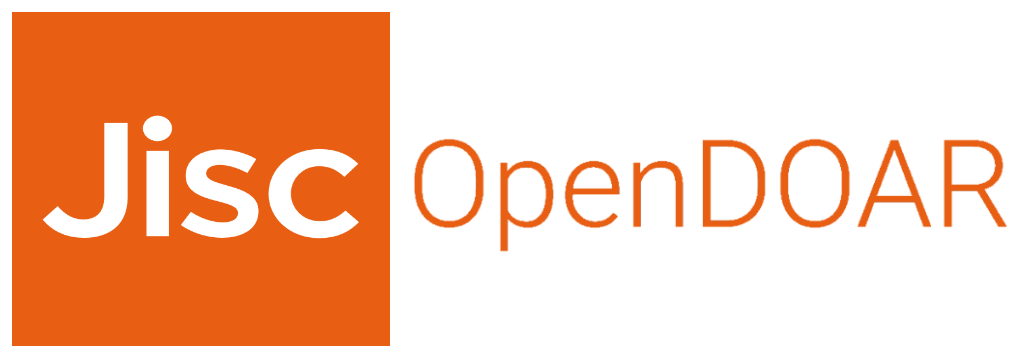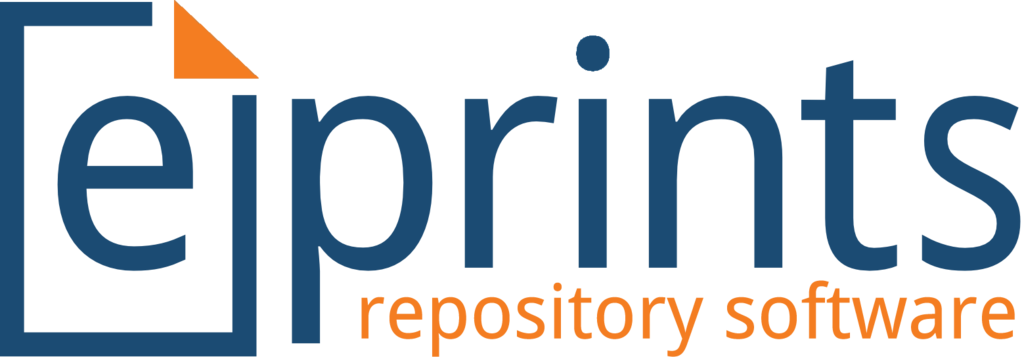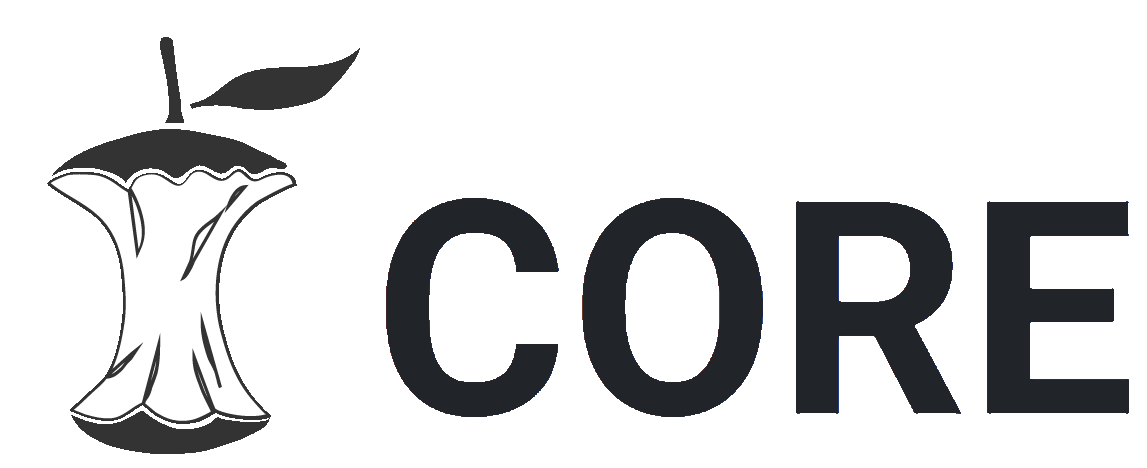Análisis de las condiciones de accesibilidad e inclusión para personas con discapacidad en los atractivos turístico de Bogotá.
Trabajo de grado - Pregrado
2020-05-20
Universidad Colegio Mayor de Cundinamarca
En este proyecto se presenta el análisis de las condiciones de accesibilidad e inclusión para
personas con discapacidad en los atractivos turístico de Bogotá. En este sentido, las personas
con discapacidad en Colombia y Bogotá representan 2.624.898 personas equivalente al (6,3%)
de la población colombiana según el DANE en el año 2018, quienes cada vez más disfrutan de su
tiempo libre en destinos turísticos, esto hace que el Turismo deba considerarse incluyente, por
esto es necesario desarrollar estrategias para suplir las necesidades de todas las personas.
Esta investigación se realizó mediante una metodología mixta, es decir que cuenta con resultados
tanto cuantitativos como cualitativos, para este fin, los autores se permitieron realizar una
observación y análisis apoyados en una herramienta denominada método Delphi (Astigarraga E.
2003), la cual permite analizar las diferentes barreras de accesibilidad con respecto a la inclusión.
Con la finalidad de hacer una delimitación más eficiente se hizo necesario realizar la
verificación de fuentes secundarias(libros, revistas, artículos científicos y otros) además de
contar con el apoyo del asesor en temas de inclusión del Ministerio de Transporte de Colombia
Dr. Ricardo Becerra, quien durante 4 de sesiones después de un dialogo que permitió definir
posturas teóricas y metodológicas específicas en temáticas de inclusión y accesibilidad validó al
equipo de investigadores las principales barreras a observar entre las cuales se encuentran la
espacial comunicativa, actitudinal y de protocolo. Con lo anterior, se puede evidenciar que la
investigación propuesta está alineada con la iniciativa del gobierno de Colombia el cual espera
convertir a la capital en un destino turístico incluyente, iniciando con el Proyecto 0740: Bogotá
ciudad turística para el disfrute de todos 2012, el Manual de turismo para todos del Mincit en
2019 y el inventario de atractivos y recursos del 2015 con el que cuenta el Instituto Distrital de
Turismo.
Ratificando que el presente trabajo utilizó una metodología mixta, se quiere profundizar en la
herramienta utilizada para hacer el análisis de los atractivos en términos de inclusión, para su
construcción, se implementó el método Delphi (Astigarraga E. 2003)el cual consta de cuatro
10
etapas (1. selección de expertos, 2. elaboración de herramienta, 3. revisión de la herramienta y
finalmente aval y puesta en práctica de la herramienta)para lograr el cumplimiento del proceso
planteado por el método seleccionado y así obtener el documento de verificación con la finalidad
de hacer la análisis en términos de inclusión de los atractivos turísticos mencionados
anteriormente, por medio de observación.
Para poder definir el número de atractivos turísticos se tomó como referencia el inventario
turístico de la ciudad de Bogotá realizado por el Instituto Distrital de Turismo –IDT- 2015;
documento que muestra que el Distrito Capital tiene 524 atractivos turísticos; siendo este un
número muy alto a analizar, por tanto, y una vez aceptada la recomendación realizada desde El
Viceministerio de Turismo específicamente por la Oficina de Accesibilidad, contando con el
profesional Germán Caicedo, recomendaron tomar aquellos atractivos por su nivel de
importancia, a nivel local, regional, nacional e internacional; otro tema para tener en cuenta es el
acceso directo a los atractivos en cuanto a ubicación y disposición, es decir, que sean de acceso
público para poder realizar todos los trabajos de campo pertinentes, reduciendo el número inicial
a 62. This project presents the analysis of the 62 tourist attractions in Bogotá in terms of
inclusion for people with disabilities. In this sense, people with disabilities in Colombia and
Bogotá represent 2,624,898 people equivalent to (6.3%) of the Colombian population according
to DANE in 2018, who increasingly enjoy their free time in tourist destinations, This means that
Tourism must be considered inclusive, for this reason it is necessary to develop strategies to meet
the needs of all people.
This research was carried out using a mixed methodology, that is, it has both quantitative and
qualitative results. For this purpose, the authors allowed themselves to carry out an observation
and analysis supported by a tool called the Delphi method (Astigarraga E. 2003), which allows
evaluate the different accessibility barriers with respect to inclusion.
In order to make a more efficient delimitation, it became necessary to verify secondary
sources (books, magazines, scientific articles, and others) in addition to having the support of the
advisor on inclusion issues of the Colombian Ministry of Transport, Dr. Ricardo Becerra , who
during 4 sessions after a dialogue that allowed defining specific theoretical and methodological
positions on topics of inclusion and accessibility validated the team of researchers the main
barriers to observe, among which are the communicative, attitudinal and protocol spatial. With
the above, it can be seen that the proposed research is aligned with the initiative of the
Colombian government which hopes to turn the capital into an inclusive tourist destination,
starting with Project 0740: Bogotá, a tourist city for the enjoyment of all 2012, the Tourism
manual for all of the Mincit in 2019 and the inventory of attractions and resources of 2015 that
the District Institute of Tourism has.
Ratifying that the present work used a mixed methodology, we want to delve into the tool
used to make the analysis of the attractions in terms of inclusion, for its construction, the Delphi
method was implemented (Astigarraga E. 2003) which consists of four stages (1. Selection of
experts, 2. Development of the tool, 3. Review of the tool and finally endorsement and
implementation of the tool) to achieve compliance with the process proposed by the selected
12
method and thus obtain the verification document with the purpose of making the analysis in
terms of inclusion of the tourist attractions mentioned above, through observation.
In order to define the number of tourist attractions, the tourist inventory of the city of Bogotá
was taken as a reference by the District Institute of Tourism –IDT- 2015; document that shows
that the Capital District has 524 tourist attractions; This being a very high number to evaluate,
therefore, and once the recommendation made by the Vice-Ministry of Tourism specifically by
the Accessibility Office was accepted, counting on the professional Germán Caicedo, they
recommended taking those attractions due to their level of importance, at the level local,
regional, national and international; Another issue to consider is direct access to attractions in
terms of location and layout, that is, they are publicly accessible so that all relevant field work
can be carried out, reducing the initial number to 62.
- ACE. Turismo [277]
Descripción:
Trabajo Final
Título: Trabajo Final.pdf
Tamaño: 1.002Mb
 PDF
PDF
 LEER EN FLIP
LEER EN FLIP
Descripción: Derechos de Autor
Título: Derechos de Autor -11.pdf
Tamaño: 299.2Kb
 PDF
PDF
Descripción: Autorización estudiantes publicación Repositorio
Título: Autorización estudiantes publicación Repositorio 6-7.pdf
Tamaño: 185.4Kb
 PDF
PDF
Título: Trabajo Final.pdf
Tamaño: 1.002Mb
 PDF
PDF
 LEER EN FLIP
LEER EN FLIP
Descripción: Derechos de Autor
Título: Derechos de Autor -11.pdf
Tamaño: 299.2Kb
 PDF
PDF
Descripción: Autorización estudiantes publicación Repositorio
Título: Autorización estudiantes publicación Repositorio 6-7.pdf
Tamaño: 185.4Kb
 PDF
PDF























